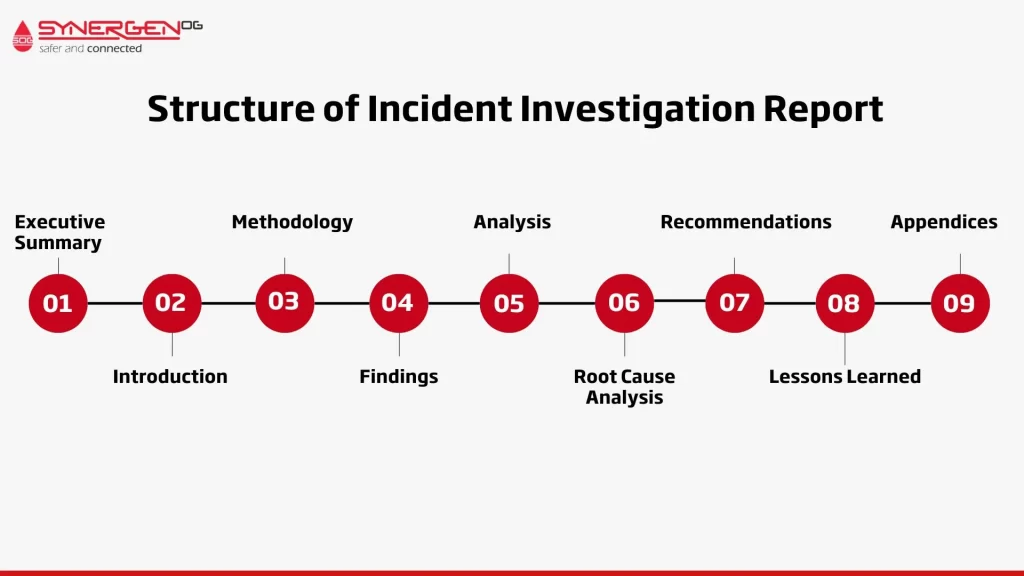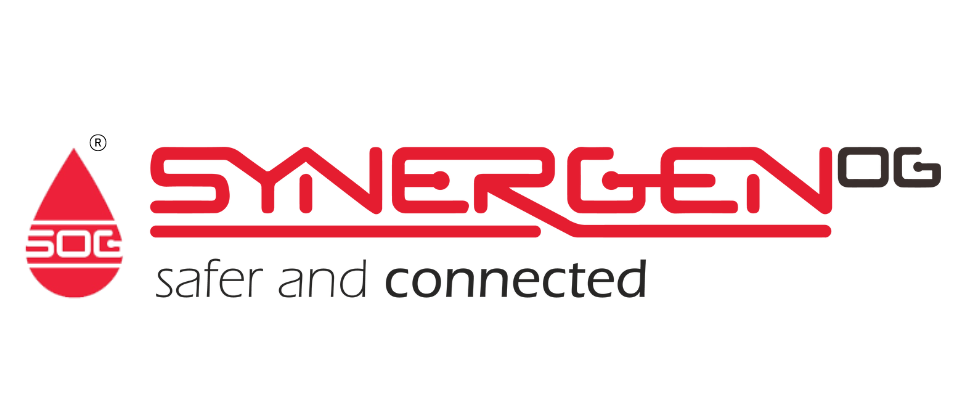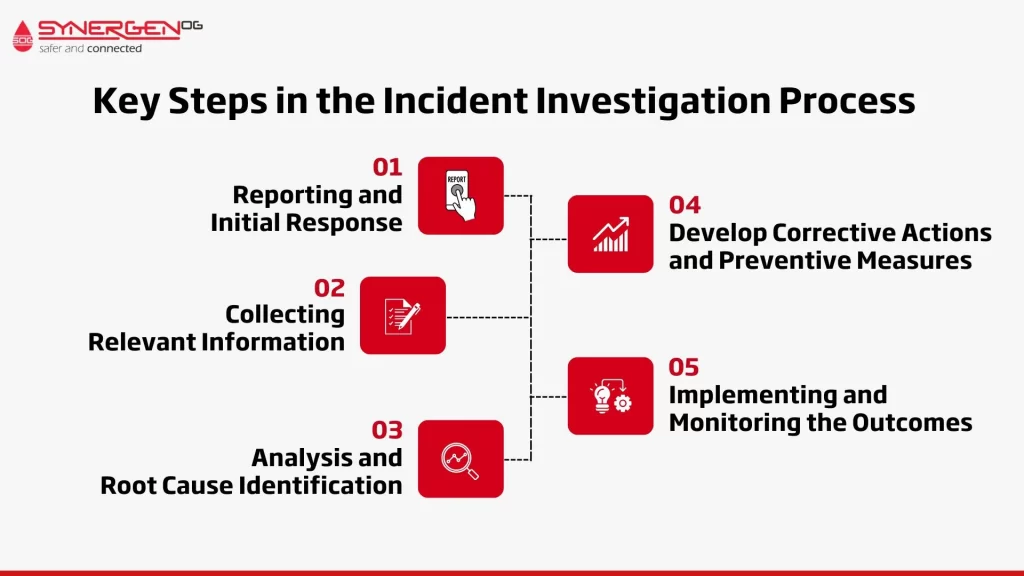| Summary: By following a structured approach and involving a multidisciplinary team, incident investigations can provide valuable insights into what went wrong and why, enabling organizations to take appropriate actions to prevent future incidents. This article on Incident Investigation helps to learn how to identify root causes, ensure workplace safety, and prevent future incidents. |
When an incident occurs in the workplace, whether it’s an accident, injury, near-miss, or property damage, it is essential to conduct a thorough investigation to determine the root causes and prevent similar incidents from happening in the future.
Importance of Incident Investigation for Workplace Safety and Compliance
Incident investigation is not just about identifying who or what was at fault; it’s about understanding the underlying causes and addressing them to create a safer work environment.
By conducting proper incident investigations, organizations can:
- Prevent Recurrence
- Protect Employees
- Improve Safety Culture
- Meet Legal and Regulatory Requirements
Understanding the Impact of Incidents on Employees and the Organization
Employee Well-being: Workplace incidents such as accidents, injuries, or near-misses can have severe physical, emotional, and psychological impacts on employees. These incidents can result in injuries, disabilities, or even fatalities, affecting the lives of individuals and their families.
Employee Morale and Productivity: Incidents in the workplace can adversely affect employee morale and productivity. Employees may lose trust in the organization’s commitment to their safety, leading to decreased motivation and engagement.
Financial Costs: Workplace incidents can lead to significant financial costs for organizations. This includes medical expenses, compensation claims, damage to equipment or property, and potential legal implications. By investigating incidents and implementing preventive measures, organizations can reduce financial losses associated with incidents, such as insurance claims and legal penalties.
Reputation and Brand Image: Incidents in the workplace can negatively impact an organization’s reputation and brand image. News of workplace accidents or safety violations can spread quickly, damaging public perception and stakeholder trust. Demonstrating a proactive approach to incident investigation and safety improvement showcases the organization’s commitment to protecting employees and maintaining a positive image.
Read: 4 Major Accidents in the 21st Century
Legal and regulatory requirements related to incident investigation
Occupational Health and Safety Laws: Many jurisdictions have specific occupational health and safety laws that require organizations to conduct incident investigations. These laws outline the types of incidents that must be reported, the timelines for reporting, and the need for investigation to determine causes and prevent recurrence.
Reporting Obligations: Organizations are often legally required to report certain incidents to regulatory authorities, such as occupational safety agencies or worker’s compensation boards. Incident investigations help organizations gather the necessary information for accurate reporting and compliance with these obligations.
Inspections and Audits: Regulatory bodies may conduct periodic inspections and audits to ensure compliance with health and safety regulations. The presence of an effective incident investigation program demonstrates an organization’s commitment to safety and can positively influence the outcome of such inspections.
Worker’s Compensation and Insurance Claims: Proper incident investigation documentation is crucial for worker’s compensation and insurance claims. Insurers often require detailed investigation reports to assess liability and determine appropriate compensation. Failure to conduct thorough investigations may hinder the ability to collect insurance benefits or lead to increased premiums.
Also Read: Process Safety Metrics for Incident Prevention and Performance Enhancement
A well-executed incident investigation involves several key steps to ensure a comprehensive analysis of the incident.
To be most effective, incident investigations should involve managers and employees working together since each brings different knowledge, understanding, and perspectives.
A team conducting an incident investigation must look beyond immediate causes instead of pointing to carelessness or failure of one particular event.
Concentrating on one particular cause and closing the investigation fails to discover the underlying or root causes of the incident, and therefore fails to identify the systemic changes and measures needed to prevent future incidents. It is important to ask why a shortcoming existed and why it wasn’t addressed previously.
Below are the essential steps in the incident investigation process.
Step 1: Reporting and Initial Response
Employees involved in incidents should understand the importance of reporting and be aware of the company procedures to follow. The initial response is critical to ensure the safety of those involved, safeguard evidence, and prevent any further incidents.
Step 2: Collecting Relevant Information
Through interviews, reviewing records, examining equipment, and analyzing other physical evidence, the investigation can identify potential contributing factors and their possible root causes. It’s essential to collect information about the environment, safety equipment, people involved, and the actual incident scenario.
Step 3: Analysis and Root Cause Identification
Investigators should seek to identify factors such as human error, equipment failure, communication breakdowns, or organizational deficiencies that contributed to the incident.
The goal is to identify the specific root causes and not just the surface issues, which will help prevent similar events from reoccurring.
Step 4: Develop Corrective Actions and Preventive Measures
Once the root causes of the incident have been identified, the next step is to develop corrective actions and preventive measures to eliminate the identified risks. These may include process improvements, training programs, equipment upgrades, or procedural changes.
The corrective actions should aim to address the identified root cause, and preventive measures should revolve around potential future incidents.
Step 5: Implementing and Monitoring the Outcomes
The most critical step in the incident investigation process is to implement the developed corrective actions and preventive measures and monitor the outcomes. Management should prioritize the implementation of the corrective and preventative actions and ensure they are communicated and understood by all staff.
The outcomes should be continuously monitored, and lessons learned should be documented to inform future decision-making processes.
Also Read: How to Conduct a Process Hazard Analysis: Methods & Steps
Techniques and Tools for Collecting Relevant Information

Collecting accurate and comprehensive information helps investigators understand the circumstances surrounding the incident and identify contributing factors. Here are some techniques and tools commonly used to collect relevant information during an incident investigation:
1. Conducting Interviews with Involved Parties
Interviewing individuals who were directly involved in or witnessed the incident is one of the most effective ways to gather information. Interviewees can provide firsthand accounts, describe their observations, and share their understanding of the events leading up to the incident.
Skilled interviewers will ask open-ended questions and actively listen to gain insights into the incident. They may interview multiple individuals to gather different perspectives and identify any discrepancies.
2. Gathering Documentary Evidence
Documentary evidence, such as incident reports, photographs, videos, and maintenance logs, can provide valuable information for an incident investigation. These documents help reconstruct the sequence of events and identify any contributing factors.
Investigators should collect and review relevant documents to ensure a comprehensive understanding of the incident. This may involve examining training records, procedure manuals, inspection reports, or any other pertinent documentation.
3. Utilizing Incident Investigation Forms and Checklists
Using incident investigation forms and checklists can help ensure all necessary information is collected during the investigation. These tools provide a structured approach to document details about the incident, including location, date, time, people involved, equipment used, and witness statements.
Incident investigation forms and checklists help standardize the investigation process and ensure key information is not overlooked.
4. Reviewing Surveillance Footage or Recordings
If available, surveillance footage or recordings from security cameras, body cameras, or audio recordings can provide valuable evidence for incident investigation.
Reviewing the footage or recordings can help validate witness statements, reconstruct the sequence of events, and identify any contributing factors or potential hazards. It is important to preserve and secure this digital evidence to ensure its integrity throughout the investigation.
5. Utilizing Technology
Technology can aid in collecting relevant information during incident investigations. Tools like incident management software, incident investigation software, database systems, and digital documentation platforms allow investigators to input, organize, and analyze information systematically.
These tools streamline the process, facilitate collaboration, and enable the generation of accurate reports and analytics.
6. Engaging Subject Matter Experts
For complex incidents, involving subject matter experts can provide valuable insights.
Subject matter experts, such as engineers, safety professionals, or equipment specialists, can contribute their knowledge and expertise to help understand technical aspects, evaluate equipment failures, or assess compliance with relevant standards and regulations.
Their expertise can aid in identifying root causes and developing effective preventive measures.
Analyzing Collected Data to Pinpoint Root Causes
The next step in safety investigation is analyzing collected data to pinpoint root causes, including common analysis techniques, identifying immediate and underlying causes, and considering contributing factors and systemic issues:
1. Common analysis techniques
- Cause and Effect Analysis: Also known as the Ishikawa or fishbone diagram, this technique helps to visually identify the various potential causes contributing to an incident. It enables investigators to categorize causes into different factors such as equipment, people, procedures, or environment.
- 5 Whys Incident Investigation: This technique involves repeatedly asking “why” to identify the underlying causes of a problem. By digging deeper into each answer, investigators can reach the root cause of an incident.
- Statistical Analysis: Utilizing statistical techniques, such as regression analysis or correlation analysis, can help identify patterns and relationships within the collected data. This analysis can provide insights into potential root causes.
2. Identifying immediate and underlying causes
Immediate Causes: These are the direct factors that led to the incident, such as equipment failure, human error, or a specific event.
Underlying Causes: These encompass the systemic or organizational factors that allow the immediate causes to occur. Examples include inadequate training, poor maintenance practices, or deficiencies in safety protocols or procedures.
3. Contributing factors and systemic issues
Contributing Factors: These are additional conditions or events that contributed to the severity or consequences of the incident. Contributing factors can include a lack of safety barriers, ineffective communication, or inadequate supervision.
Systemic Issues: These refer to the broader, systemic problems within an organization or industry that create an environment conducive to incidents. Systemic issues can include deficient safety culture, lack of management commitment to safety, or insufficient regulatory oversight.
Also Read: 14 Standard Elements of Process Safety Management
Implementing Corrective Actions and Preventive Measures
After conducting an incident investigation and identifying the root causes, it is important to develop an action plan based on the findings. This action plan should outline the specific corrective actions and preventive measures to be implemented to address the identified issues and prevent similar incidents from occurring in the future.
The major steps involved in implementing corrective actions and preventive measures are,
Developing an Action Plan: The action plan should clearly outline the corrective actions and preventive measures based on the investigation findings. The plan should include specific tasks, objectives, and desired outcomes.
Assigning Responsibilities and Setting Timelines: Assigning clear responsibilities to individuals or teams within the organization is crucial for the successful implementation of the action plan.
Each task should have a designated person responsible for its completion. Additionally, setting realistic timelines is important to ensure that progress is made in a timely manner.
Implementing Corrective Actions: Corrective actions should be focused on addressing the root causes identified during the investigation. These actions may include repairing or upgrading equipment, revising procedures, enhancing training programs, or implementing new safety measures.
It is important to consider the hierarchy of controls, which prioritizes the elimination or substitution of hazards over-reliance on administrative controls or personal protective equipment.
Implementing Preventive Measures: Preventive measures aim to establish controls and practices that prevent incidents from occurring in the first place. This may involve conducting risk assessments, implementing robust safety management systems, establishing effective communication channels, and fostering a strong safety culture.
Monitoring Progress and Effectiveness: Regular monitoring and evaluation are essential to assess the progress and effectiveness of the implemented measures. This should done through various methods, such as inspections, audits, incident reporting systems, and performance indicators.
It is important to track and analyze data to ensure that the implemented measures are achieving the desired outcomes and making a positive impact on safety.
Making Adjustments if Necessary: If monitoring reveals that the implemented measures are not achieving the desired outcomes, it may be necessary to make adjustments to the action plan. This could involve revisiting the root causes, reassessing the effectiveness of the measures, and making appropriate modifications or enhancements.
How to Create an Incident Investigation Report?
A well-structured and effectively communicated incident investigation report helps to ensure that the information is understood and actions are taken to prevent similar incidents in the future.
Structure and Considerations of an Incident Investigation Report

1) Executive Summary: This section provides a concise overview of the incident, including a summary of the findings, root causes, and recommendations. It should give a high-level understanding of the incident to readers who may not have the time to read the entire report.
2) Introduction: The introduction sets the context for the incident investigation by providing necessary background information, describing the incident and its impact, and stating the purpose and scope of the report.
3) Methodology: This section describes the approach and methods used to conduct the investigation, including data collection techniques, analysis tools, and any external resources or experts involved.
4) Findings: Present the detailed findings of the investigation, including a chronological account of events, factual information collected, and key observations. Ensure that the findings align with the incident investigation objectives and answer the “what” and “how” of the incident.
5) Analysis: Analyze the findings to identify the causal factors and root causes of the incident. Employ various analysis techniques, such as cause and effect diagrams, relationship matrices, or statistical analysis, to support the conclusions drawn.
6) Root Cause Analysis: Identify the underlying causes that contributed to the incident. Use techniques such as the “5 Whys” or methods like “BowTie analysis” to facilitate a thorough understanding of the fundamental reasons behind the incident.
7) Recommendations: Provide specific and actionable recommendations to prevent similar incidents. Recommendations should be practical, prioritized, and consider the hierarchy of controls. Clearly define responsibilities, timelines, and resources required for implementing each recommendation.
8) Lessons Learned: Summarize the key lessons learned from the incident investigation, highlighting best practices, areas for improvement, and potential safety culture enhancements.
9) Appendices: Include any supporting documentation, such as photographs, witness statements, incident reports, or data analysis results, as appendices for reference.
To communicate the findings and recommendations effectively, it is important to consider the following,
- Clarity
- Audience
- Format
- Visuals
- Conciseness
- Language
- Timeliness
Conclusion
Successful incident investigations lead to the identification of specific factors that contributed to the incident, the implementation of targeted corrective actions, and the establishment of preventive measures.
The findings and lessons learned from these investigations drive positive changes in safety protocols, training programs, and overall control measures. Ultimately, incident investigations serve as catalysts for continuous improvement, fostering a safer work environment for employees and all stakeholders involved.



[…] Read More on Incident Investigation: https://synergenog.com/process-incident-investigation/ […]